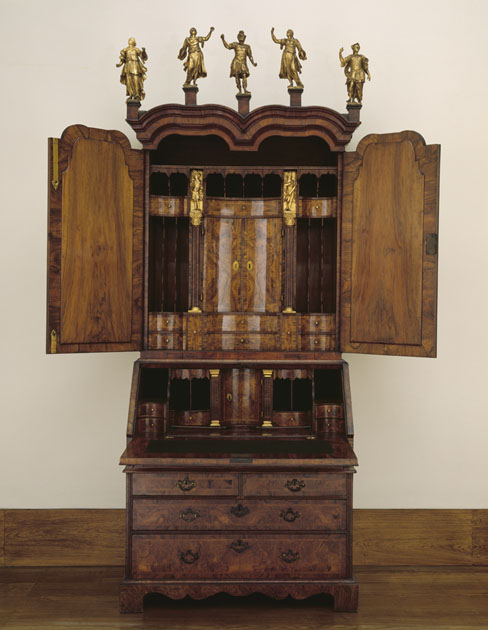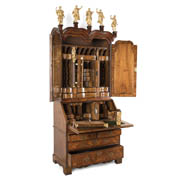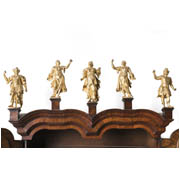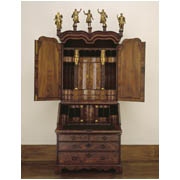Details
- Object type
bureau bookcase
- Place Associated
England (place of manufacture)
- Date
circa 1720-1730
- Materials
Oak / oak deal, walnut and burr walnut veneer, brass, gilt woodwork, gesso and bole, mirrored glass and green baize
- Dimensions
overall: 2600 mm x 1390 mm x 607 mm 170 kg
- Description
-
This eighteenth-century bureau bookcase, combines the functions of cabinet, writing desk and pier glass, and represents the union of chest of drawers, desk, and bookcase. The surfaces of the bureau bookcase are veneered throughout in burr walnut, while the inside carcase and drawers are made of oak and deal. The swirling, marbled effect of the walnut burr came from slicing the walnut tree at the base where roots and growths would occur and spread. As these growths were often not commonly found, it was hard to acquire large pieces of solid walnut burr to use throughout the whole furniture structure; instead, eighteenth-century cabinet makes would apply veneers of the walnut burr to the exterior sometimes with small pieces carefully bended together.
Bureau bookcases were a costly, luxury furniture item in the 1700s. The shape and style of these bureaus developed in France during the 1600s but did not become fashionable in Britain until the start of the eighteenth century. Bureaus of this type were predominantly placed in bedrooms or dressing rooms, with the cabinet being used for documents, correspondence and writing materials and the drawers below for the storage of clothing. Some bureaus were also used a dressing table; the locked compartments, doors, and drawers used for the storage of expensive cosmetics and jewellery.
The upper cabinet section stands on a shallow base that contains a pair of candle slides. It has a pair of mirror-glass doors concealing numerous compartments and drawers. The mirrors, and the upper corner sections of the mouldings that contain them, are most probably modern replacements, but follow the form of the eighteenth-century originals. The candle slides under the mirrored doors can be pulled out to hold of candles. Once lit, the candles would reflect in the closed mirrored doors, giving the room the illusion of extra light. The top of the upper is formed in a shaped and tiered cornice surmounted with five gilded golden figures of classical heroes on raised pedestals. The figures include the Greek god Apollo, god of music, truth and prophecy, and Mars, the Greek god of war. The central figure, flanked by two female classical figures, is Justice identified by the blindfold she wears across her eyes. Her hand probably once carried a set of scales, but these have been lost over time.
Behind the mirrored doors is a central compartment with a central cupboard space enclosed with a pair of walnut burr veneer concave doors between a pair of fluted pilasters (rectangular columns), topped with wooden-gilt golden classical figures. Above the pilasters, there is a row of eight ‘pigeonholes’ with three long letter holes flanking either side of the central enclosed compartment. The inside cabinet base finishes with a set of six veneered drawers of various sizes, with gilt-brass handles.
The lower desk section has a fall front, with a modern panel of green baize fitted in the writing-slope. When closed, the bureau has mirrored cabinet doors above a sloped front, that can be used as a writing-slope. The sloped front can be opened to form the writing desk. Within the desk space is a central compartment with a veneered concave door between a pair of fluted pilasters, these flanked by three pairs of letter-holes and three pairs of small drawers. In the floor of the desk, the panel slides back revealing a hidden well underneath of the storage of important documents. The cabinet has additional concealed, secret compartments for hiding important documents and valuables; the gilt fluted pilasters inside the upper cabinet can also be pulled out to reveal they are hollow rectangular box compartment for the stashing of valuables.
Provenance: Rosalind Frances Howard, Countess of Carlisle (1845-1921); Frank Partridge & Son (dealers) from whom purchased by William Burrell on 1 July 1925 for £631
- Credit Line/Donor
Gifted by Sir William and Lady Burrell to the City of Glasgow, 1944
- Collection
Burrell Collection: Furniture
- ID Number
14.331
- Location
In storage





